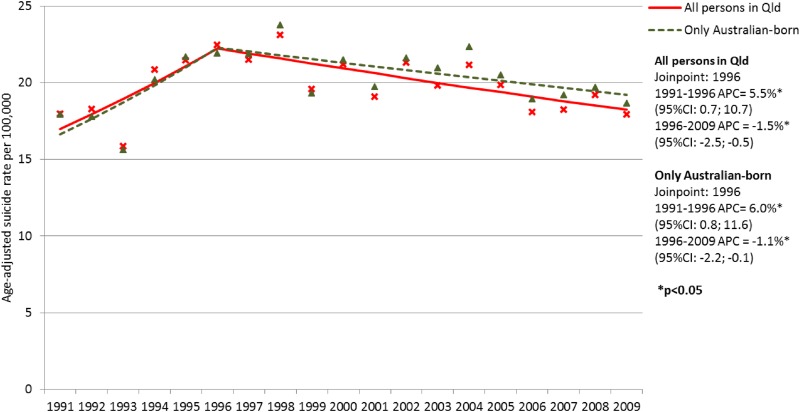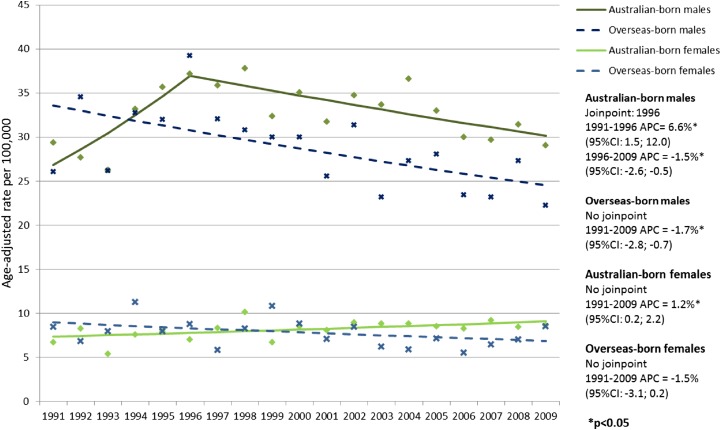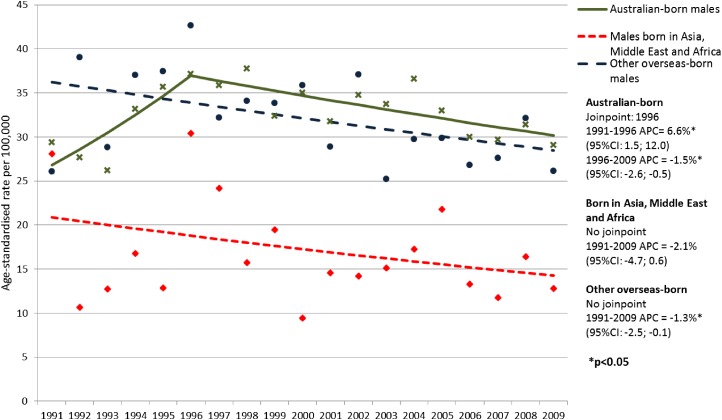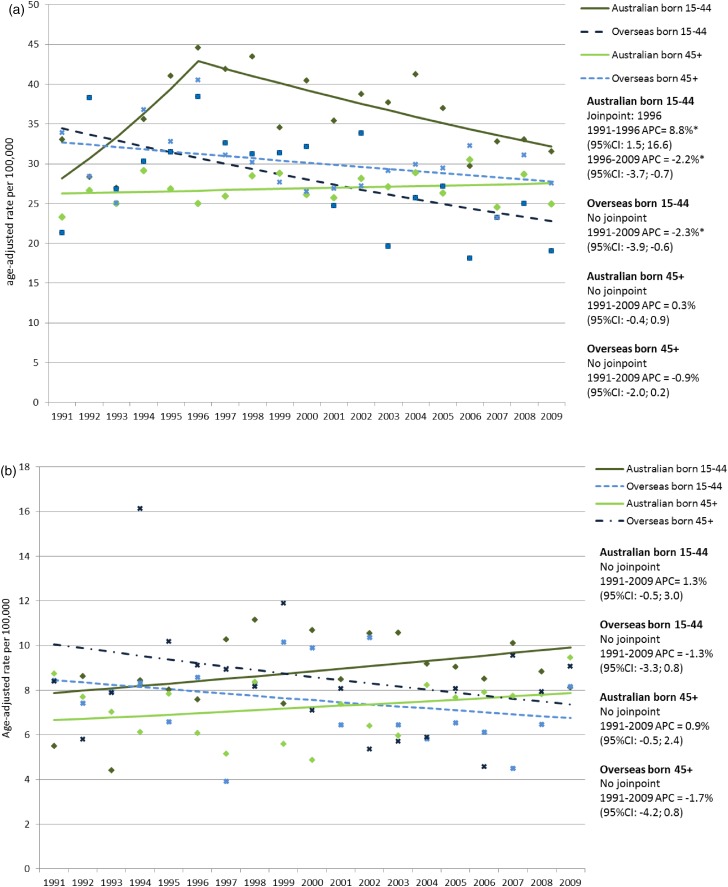Abstract
Aims.
This study aims to examine Queensland suicide trends in the Australian-born population and in the overseas-born populations over the past 2 decades.
Methods.
All suicide cases for the period 1991–2009 were identified in the Queensland Suicide Register. Age-standardised suicide rates were calculated. Joinpoint regression and Poisson regression were applied.
Results.
A significant decline in suicide rates of young (15–44 years) overseas-born males was reported over the past 2 decades. Australian-born young males showed significant increase until 1996, followed by a significant decline; furthermore, their suicide rates were significantly higher when compared to overseas-born (RR = 1.36, 95%CI: 1.15; 1.62). Contrary older Australian-born males (45+ years) had significantly lower suicide rates than overseas-born males (RR = 0.90, 95%CI: 0.83; 0.98). Despite the convergence of the suicide trends for older males, changes were not significant. While Australian-born females had a significant increase in suicides, overseas-born females had a decline in 1991–2009.
Conclusions.
Conclusion. Significantly declining suicide rates of migrants have contributed to the declining in suicide trends in Queensland. Potential reasons for significantly lower suicide rates among young migrants might include the change in the nature of migration from involuntary to voluntary.
Key words: Australian-born, overseas-born, suicide rates, voluntary migration
Introduction
Place of birth plays a crucial role in our lives; it is closely related to our ethnicity and genetic makeup; it influences socialisation through culture, values, beliefs and other external factors and, overall, helps to form who we are – our identity. Relocation to a foreign country demands adjustment to the new physical, social, cultural and economic environments. Experiences in the home country, reasons for the migration, and conditions in the new host country have their impact on a person's physical and mental health (Bhugra, 2004). On the aggregated level, it has been suggested that suicide rate patterns in first-generation migrants reflect those of their birth countries. This may be due to the social and cultural norms of home country (Ide et al. 2012), but also to particular genetics (Voracek & Loibl, 2008). Furthermore, there has been some indication that – with time – immigrant suicide rates tend to converge towards the rates of the host country over time (Kliewer & Ward, 1988).
Australia is a country with a high proportion of overseas-born people in the population. According to the 2011 Census, 27% of the Australian population was born overseas, and this proportion has been increasing (it was 22% according to the 1991 Census). In Queensland, overseas-born population aged 15 years and older has almost doubled, from 435 000 in 1991 (Australian Bureau of Statistics, 1993) to 816 000 in 2011 (Australian Bureau of Statistics, 2012a). Furthermore, the overall composition of Australia's population has changed considerably. This is particularly related to increases in migration from Asia, Africa and the Middle East since 1970s (Department of Immigration and Multicultural Affairs, 2001; Australian Bureau of Statistics, 2011; Ide et al. 2012). In Queensland, Asian-born population aged 15 years and older has increased 3.5 times in past 2 decades from 52 120 in 1991 to 184 456 in 2011 and population born in Africa and Middle East 4.5 times from 14 712 to 65 981, while European-born population has increased 1.2 times between 1991 and 2011. Considering the increasing share of overseas-born individuals in the population, and more specifically their different background it is important to observe possible changes in suicide trends and analyse if these may influence overall suicide rates in Australia. Consequently, the aim of the present study was to examine suicide trends in the Australian-born population and in the overseas-born population over the past 2 decades in one state of Australia, Queensland, where is also located a high-quality databank on suicide, the Queensland Suicide Register (QSR).
Method
Data sources
All suicide cases for the period 1991–2009 were identified through the QSR. The QSR is a comprehensive suicide database maintained by the Australian Institute for Suicide Research and Prevention (AISRAP). Information is obtained from difference sources, including police investigations, police interviews with the deceased's next-of-kin using a psychological autopsy questionnaire (Form 1), post mortem reports, toxicology results, and coroner's findings (inclusive who the deceased person is, how the person died (narrative of circumstances of death), when and where the person died and what caused the person to die). Hospital records often supplement this information. Following AISRAP's Suicide Classification Flow Chart, all suicide cases in the QSR are classified into one of three categories as following:
-
–
Beyond reasonable doubt: The available information refers to one or more significant factors that, in combination, constitute a pattern highly indicative of suicide.
-
–
Probable: The available information is not sufficient to allow for a judgement of ‘beyond reasonable doubt’, but is still more consistent with a death by suicide than by any other cause.
-
–
Possible: The available information is suggestive of a suicide, but there remains a substantial possibility that the death may be due to other internal or external causes of death (De Leo et al. 2013).
For the present analyses, only those cases falling into the categories of either Beyond Reasonable Doubt or Probable were included.
Although QSR holds information on the country of birth (COB) of decedents, cases with missing information were further linked with information from the Queensland Registry of Births, Deaths and Marriages. In total, 10 058 suicides in Queensland were recorded in the QSR between 1991 and 2009; however, after data linkage, 305 suicide cases remained without information about their COB (3.03%) and were excluded from the analysis. The study was approved by the Griffith University Human Research Ethics Committee (CSR/02/10/HREC).
In this study, any individual born overseas, but whose usual residence was in Australia, was considered to be an overseas-born person or a first-generation migrant. As per the Australian Bureau of Statistics (ABS) definition, ‘usual residence’ does not include persons who usually live in another country and are visiting Australia for less than 1 year (Australian Bureau of Statistics, 2006a). Population data by COB categorised by gender and age group for Queensland were obtained from the ABS from the 1991, 1996, 2001, 2006 and 2011 Censuses of Population and Housing. For inter-census years, population numbers were calculated using population growth separately for the Australian-born and different overseas-born populations by gender and age group (United Nations, 2002).
In the time interval considered, there has been an increase in the missing data by COB (from 2.0% in 1991 to 6.1% in 2011 for Queensland). This has mostly been attributed to the increase in non-response rates to the Census due to the rising number of centrally gated communities and apartment blocks, which make it difficult for Census collectors to contact occupants (Australian Bureau of Statistics, 2006b).
Suicide rates were calculated using the population aged 15+ years, due to the relatively low occurrence of suicide in the youngest age group (0–14 years). Furthermore, there are remarkable differences in the age distribution between the Australian and overseas-born populations (especially in longer-standing migrants), particularly in the age group under 15 years. This is in line with an historical Australian study by Burvill (1998). Overall suicide rates were age-standardised using the World Standard Population. Poisson regression analysis was applied for group comparisons by age group, and COB – Australian versus overseas. Rate ratios (RR), with 95% confidence intervals (95% CI), are presented. A few cases of over-dispersed models were fitted. The analysis was performed with IBM SPSS version 20.0. The joinpoint regression analysis was used to identify the best-fitting points where a statistically significant change in the trend occurred. The annual percentage change(s) (APC) with 95%CI are presented. The analysis was performed with Joinpoint Regression Program version 4.0.4 (http://surveillance.cancer.gov/joinpoint/).
Results
Joinpoint regression analysis between 1991 and 2009 in Queensland (Fig. 1), the total age-standardised suicide rates (ASR) for persons aged 15 years and over showed a significant increase until 1996 (APC = 5.5%; 95%CI: 0.7; 10.7) with 1996 identified as a joinpoint. This was followed by a significant decline (APC = −1.5%; 95%CI: −2.5; −0.5). Similar pattern was shown for only Australian-born persons; however, the decline was slightly slower (APC = −1.1%; 95%CI: −2.2; −0.1).
Fig. 1.
Suicide trends (age 15+ years) using Joinpoint regression with annual percentage change (APC) with 95% confidence intervals (CI) in Queensland.
Suicide rates in males
The mean ASR was 32.65 per 100 000 (SD = 3.34) for Australian-born males and 28.69 (SD = 4.44) for overseas-born males during the study period (1991–2009). The joinpoint regression analysis identified that 1996 was a joinpoint for Australian-born males (Fig. 2), more specifically, Australian-born males had significant upward trend between 1991 and 1996 (APC = 6.6%; 95%CI: 1.5; 12.0) followed by a significant decrease (APC = −1.5%; 95%CI: −2.6; −0.5). Overseas-born males had a significant downward trend during the study period (APC = −1.7%; 95%CI: −2.8; −0.7). Overseas-born males where further divided into following groups (from the highest to the lowest ASR): New Zealand born males (33.15, SD = 7.02), European-born males (31.54, SD = 5.93), other Oceania-born (25.40, SD = 15.69), Americas-born males (25.35, SD = 14.36), Middle East and African-born males (24.21, SD = 11.75) and Asian-born males (14.35, SD = 7.20). Considering that for some regions there excisted years with zero incidence, the joinpoint regression was performed together for Middle East and African-born and Asian-born males and for other overseas-born males (Fig. 3). Both groups showed declining trends without joinpoints; it was stronger for males born in Asia, Middle East and Africa, but not significant due to small numbers (APC = −2.1%; 95%CI: −4.7; 0.6). However, it was significant for other overseas-born males (APC = −1.3%; 95%CI: −2.5; −0.1).
Fig. 2.
Suicide trends (age 15+) using Joinpoint regression with annual percentage change (APC) with 95% confidence intervals (CI) by country of birth and gender.
Fig. 3.
Suicide trends (age 15+) using Joinpoint regression with annual percentage change (APC) with 95% confidence intervals (CI) in males by country of birth.
In the age group 15–44 years, the mean ASR was 36.17 per 100 000 (SD = 5.15) for Australian-born males and 27.92 (SD = 6.10) for overseas-born males during the study period. The Poisson regression analysis indicated that Australian-born males aged 15–44 years had significantly higher suicide rates during the study period compared with overseas-born males in the same age bracket (RR = 1.29, 95%CI: 1.19; 1.39; p < 0.001). The joinpoint analysis indicated that there was a significant joinpoint for Australian males aged 15–44 years (Fig. 4a); more specifically, there was a significant upward trend between 1991 and 1996 (APC = 8.8%; 95%CI: 1.5; 16.6), followed by a significant downward trend between 1996 and 2009 (APC = −2.2%; 95%CI: −3.7; −0.7). There was a significant downward trend for overseas-born males in the same age group during the whole study period (APC = −2.3%, 95%CI: −3.9; −0.6).
Fig. 4.
(a) Suicide trends using Joinpoint regression with annual percentage change (APC) with 95% confidence intervals (CI) in males by country of birth and age group. (b) Suicide trends using Joinpoint regression with annual percentage change (APC) with 95% confidence intervals (CI) in females by country of birth and age group.
For males aged over 45, the mean suicide rate was 27.65 per 100 000 (SD = 1.91) for the Australian-born and 29.97 (SD = 4.10) for the overseas-born during the period 1991–2009. Unlike younger males, Australian-born males aged 45 and over had lower suicide rates than overseas-born males during the study period (RR = 0.90, 95%CI: 0.83; 0.98; p = 0.013). There was some decrease for overseas-born males aged 45 years and older and some increase for Australian-born males; however, those trends were not significant (Fig. 4a).
Furthermore, comparison of Australian-born males by age group showed that the younger age group (15–44 years) had significantly higher suicide rates than the older age group (45+ years) during the full study period (RR = 1.35, 95%CI: 1.28; 1.42; p < 0.001). The difference between the older and younger age groups was not significant for overseas-born males (RR = 0.95, 95%CI: 0.86; 1.05; NS).
Suicide rates in females
The mean ASR was similar for Australian-born and overseas-born females during the study period: 8.12 per 100 000 (SD = 1.07) and 7.73 (SD = 1.58), respectively. The Joinpoint regression analysis did not identify any Joinpoints for either groups (Fig. 2), nevertheless, Australian-born females had significant upward trend (APC = 1.2%; 95%CI: 0.2; 2.2), whereas overseas-born females had a non-significant downward trend (APC = −1.5%; 95%CI: −3.1; 0.2).
The mean suicide rate was 8.71 per 100 000 (SD = 1.74) for Australian-born females aged 15–44 years and 7.39 (SD = 1.77) for overseas-born females in the same age group (Fig. 4b). The Poisson regression revealed that Australian-born females had significantly higher suicide rates compared with overseas-born females aged 15–44 years (RR = 1.18, 95%CI: 1.02; 1.37; p = 0.030). For older females (aged over 45 years), the mean suicide rate was 7.16 per 100 000 (SD = 1.27) for Australian-born and 8.30 (SD = 2.63) for overseas-born during the period 1991–2009 (Fig. 3). Despite Australian-born females aged 45 years and over had lower suicide rates, it was not statistically significant (RR = 0.88, 95%CI: 0.75; 1.02; NS). Both Australian-born female age groups had an upward trend and both overseas-born female age groups had a downward trend; however, trends were not significant (Fig. 4b).
Similarly to males, comparison of Australian-born females by age group showed that the younger age group (15–44 years) had significantly higher suicide rates than the older age group (45+ years) in 1991–2009 (RR = 1.25, 95%CI: 1.13; 1.38; p < 0.001). The difference between the older and younger age groups was not significant for overseas-born females (RR = 0.93, 95%CI: 0.77; 1.12; NS).
Discussion
It has been recently stated that there has been a decrease of 17% in suicide rates in Australia over the past decade (all ages included): from 12.7 (in 2001) to 10.5 deaths per 100 000 people (in 2010) (Australian Bureau of Statistics, 2012b). Caution is obviously needed when citing these figures considering that, at the time of this ABS report, suicide figures were not finalised for the years 2009 and 2010, and still had to go through the formal revision process. In fact, in Australia, official suicide mortality data were revised after the discovery of substantial under-reporting (De Leo, 2010; Williams et al. 2010). The revision process has concerned the years 2006 on, and has involved/involves the publication for each year of a ‘preliminary’ count, followed by the ‘1st Revision’ after one year, and the final dataset in two year-time from the initial publication of data related to a given year. The difference reported by the ABS on the decade 2001–2010 raises the obvious question whether the reduction is due to the efforts of suicide prevention activities and/or to some other factors, including socio-demographic variations, in particular the much increased presence of Asian-born new citizens. In our study, changes in suicide trends among Australian- and overseas-born people have been analysed using QSR data, the quality of which is thought to be better than ABS data (De Leo, 2010; Williams et al. 2010), and actually has prompted the revisions by the ABS.
Current analysis showed a significant increase in suicide rates until 1996, followed by a significant decline for all persons aged over 15 years in Queensland. While the decline since 1996 was not that fast for Australian-born population, it could be explained by the contribution of declining suicide trends of overseas-born populations in Queensland since 1991. In particular there is a strong influence of suicides in young males (15–44 years old), more specifically, Australian-born males showed a significant drop since 1996, however, suicide rates in overseas-born males in the age bracket 15–44 years were significantly lower and declined slightly faster. The discrepancies between Australian-born and overseas-born started from 1990s for males, when Australian-born males had a rising trend till 1996, which is in accordance with the findings of Ide et al. (2012); however, that analysis did not consider age groups. In addition, Burvill (1998) presented relatively similar suicide rates for Australian- and overseas-born males and females for the period 1979–1990 with rising trends for males of both groups in the second parts of 1980s.
Similarly to males, overseas-born females had a decreasing suicide trend; however, Australian-born females had significantly rising trend, which contributed to the slight increase for all Queensland females since 1991. In addition, significantly higher suicide rates were observed in Australian-born females aged between 15 and 44 years compared with the overseas-born females.
An important factor contributing to the decrease in the suicide rates of young overseas-born migrants could be the change in the composition of first-generation migrants. In the past 3 decades, there has been a marked increase in the overseas-born populations from Asian and also African countries. The proportion of Asians increased from 24% of the overseas-born population in 2001 to 33% in 2011 (Australian Bureau of Statistics, 2012a). At the same time, the number of people born in European countries has remained at the same level or even decreased; so, the share of Europeans in the overall overseas-born population has decreased. As indicated earlier and shown in this analysis, Asian-, Middle Eastern- and African-born people show significantly lower suicide rates when compared to Australian-born individuals (Burvill, 1998; Ide et al. 2012) and contribute to the overall decline in Australian rates.
Nevertheless, it is important to note that suicide trends showed decline for different overseas-born populations. This leads us to the other potential reasons for lower suicide rates among young migrants, which might include the contemporaneous change in the nature of migration from involuntary to voluntary, which contributes to the ‘healthy migrant effect’ (Kwan & Ip, 2007; Newbold, 2005). However, the durability of this effect is uncertain, since the mental health of migrants has been shown to worsen after their arrival in Australia (Anikeeva et al. 2010). Furthermore, it is important to note that people from some Asian countries, such as China and India, use highly lethal pesticides as means of suicide (~62% in China (Phillips et al. 2002) and 45% in India (Patel et al. 2012)). Those means are not easily available in Australia and this might contribute to keep low (if not lower) rates of suicide for those immigrants by the limited availability of their traditional suicide methods. However, this hypothesis needs further testing.
Contrary to the 15–44 year age group, Australian-born males aged over 45 years had significantly lower rates than overseas-born; however, rates showed convergence with some increase in Australian-born and decrease in overseas-born males aged over 45 years. A similar trend was observed in females aged 45 years and over. Overall suicide trends were relatively stable, showing no significant changes. Convergence in suicide rates in the older age bracket might also partly reflect changes in the composition of migrants.
The main limitation of the current study is the relatively limited time period (starting from 1991) and its incapability of distinguishing between specific countries of birth, even analysis within wider groups was limited due to small numbers (some year(s) with zero incidence). However, significantly declining suicide rates of migrants have contributed to the declining in suicide trends in Queensland. Although this was not analysed in the frames of the current paper, there seem to be no reason to imagine that the same influence could have been exerted on the entire country, causing an appreciable lowering of national suicide rates. From this point of view, it may be stated that besides the ‘healthy immigrant effect’, a healthier country appears to be an outcome of the active presence of immigrants. Furthermore, considering the increase in migration worldwide, its impact on suicide rates should be analysed in other countries as well.
Acknowledgements
We would like to thank Delaney Skerrett for his thorough linguistic revision of the manuscript.
Financial Support
Queensland Health provides continues funding and support in the management of the Queensland Suicide Register, which was used as the primary data source. Additional information from the Queensland Registry of Births, Deaths and Marriages was crucial for this analysis.
Conflict of Interest
None.
Ethical Standards
The authors assert that all procedures contributing to this work comply with the ethical standards of the relevant national and institutional committees on human experimentation and with the Helsinki Declaration of 1975, as revised in 2008.
References
- Anikeeva O, Bi P, Hiller JE, Ryan P, Roder D, Han G-S (2010). The health status of migrants in Australia: a review. Asia Pacific Journal of Public Health 22, 159–193. [DOI] [PubMed] [Google Scholar]
- Australian Bureau of Statistics (1993). Census Characteristics of Australia, 1991 Census of Population and Housing. Commonwealth of Australia: Canberra. [Google Scholar]
- Australian Bureau of Statistics (2006a). Census Dictionary 2006. Commonwealth of Australia: Canberra. [Google Scholar]
- Australian Bureau of Statistics (2006b). 2006 Census Non-Response Rates Fact Sheets. Commonwealth of Australia: Canberra. [Google Scholar]
- Australian Bureau of Statistics (2011). Migration, Australia, 2009–2010. Commonwealth of Australia: Canberra. [Google Scholar]
- Australian Bureau of Statistics (2012a). Reflecting a Nation: Stories from the 2011 Census, 2012–2013. Commonwealth of Australia: Canberra. [Google Scholar]
- Australian Bureau of Statistics (2012b). Suicides, 2010, Australia. Commonwealth of Australia: Canberra. [Google Scholar]
- Bhugra D (2004). Migration and mental health. Acta Psychiatrica Scandinavica 109, 243–258. [DOI] [PubMed] [Google Scholar]
- Burvill PW (1998). Migrant suicide rates in Australia and in country of birth. Psychological Medicine 28, 201–208. [DOI] [PubMed] [Google Scholar]
- Department of Immigration and Multicultural Affairs (2001). Immigration: Federation to Century's End 1901–2000. Commonwealth of Australia: Canberra. [Google Scholar]
- De Leo D (2010). Australia revises its mortality data on suicide. Crisis 31, 169–173. [DOI] [PubMed] [Google Scholar]
- De Leo D, Sveticic J, Kumpula EK (2013). Suicide in Queensland, 2008–2010: Mortality Rates and Related Data. Australian Institute for Suicide Research and Prevention: Brisbane. [Google Scholar]
- Ide N, Kolves K, Cassaniti M, De Leo D (2012). Suicide of first-generation immigrants in Australia, 1974–2006. Social Psychiatry and Psychiatric Epidemiology 47, 1917–1927. [DOI] [PubMed] [Google Scholar]
- Kliewer E, Ward RH (1988). Convergence of immigrant suicide rates to those in the destination country. American Journal of Epidemiology 127, 640–653. [DOI] [PubMed] [Google Scholar]
- Kwan YK, Ip WC (2007). Suicidality and migration among adolescents in Hong Kong. Death Studies 31, 45–66. [DOI] [PubMed] [Google Scholar]
- Newbold KB (2005). Self-rated health within the Canadian immigrant population: risk and the healthy immigrant effect. Social Science & Medicine 60, 1359–1370. [DOI] [PubMed] [Google Scholar]
- Patel V, Ramasundarahettige C, Vijayakumar L, Thakur JS, Gajalakshmi V, Gururaj G, Suraweera W, Jha P, Million Death Study Collaborators (2012). Suicide mortality in India: a nationally representative survey. Lancet 379, 2343–2351. [DOI] [PMC free article] [PubMed] [Google Scholar]
- Phillips MR, Yang G, Zhang Y, Wang L, Ji H, Zhou M (2002). Risk factors for suicide in China: a national case-control psychological autopsy study. Lancet 360, 1728–1736. [DOI] [PubMed] [Google Scholar]
- United Nations (2002). Methods for Estimating Adult Mortality. (ESA/P/WP.175.) Department of Economic and Social Affairs, Population Division: New York. [Google Scholar]
- Voracek M, Loibl LM (2008). Consistency of immigrant and country-of-birth suicide rates: A meta-analysis. Acta Psychiatrica Scandinavica 118, 259–271. [DOI] [PubMed] [Google Scholar]
- Williams RF, Doessel DP, Sveticic J, De Leo D (2010). Accuracy of official suicide mortality data in Queensland. Australian and New Zealand Journal of Psychiatry, 44, 815–822. [DOI] [PubMed] [Google Scholar]






